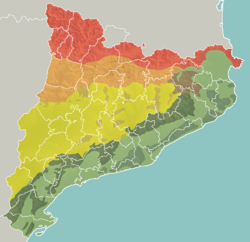Catalan Mediterranean System facts for kids

- Pyrenees
- Pre-Pyrenees
- Catalan Central Depression
- Smaller mountain ranges of the Central Depression
- Catalan Transversal Range
- Catalan Pre-Coastal Range
- Catalan Coastal Range
- Catalan Coastal Depression and other coastal and pre-coastal plains
The Catalan Mediterranean System is a large coastal area in Catalonia, Spain. It is also known by other names like the Mediterranean System or Catalanid System. This region is special because it has two main mountain ranges along the coast. These are the Catalan Coastal Range and the Catalan Pre-Coastal Range. Between these mountains, you'll find flat areas called the Catalan Coastal Depression and other plains.
How the Mountains Formed (Geology)
The Catalan Mediterranean System was created by a geological process called tectonic uplift. Imagine the Earth's crust slowly pushing upwards. This uplift formed a long area, about 300 kilometers (186 miles) long and 50 kilometers (31 miles) wide.
Different Parts of the System
This system can be divided into three main parts from north to south:
- Northern Zone: This part is located between the Empordà area and the Llobregat River. Its rocks are very old, formed during the Paleozoic era. They are mostly crystalline rocks, which means they have a clear, organized structure.
- Central Zone: This area stretches between the Llobregat River and the Ebro River.
- Southern Zone: This part goes from the Baix Ebre area all the way to the Millars River in the Valencian Community. Both the central and southern zones have rocks formed during the Mesozoic and Tertiary periods.
See also
 In Spanish: Cordilleras Costero-Catalanas para niños
In Spanish: Cordilleras Costero-Catalanas para niños

